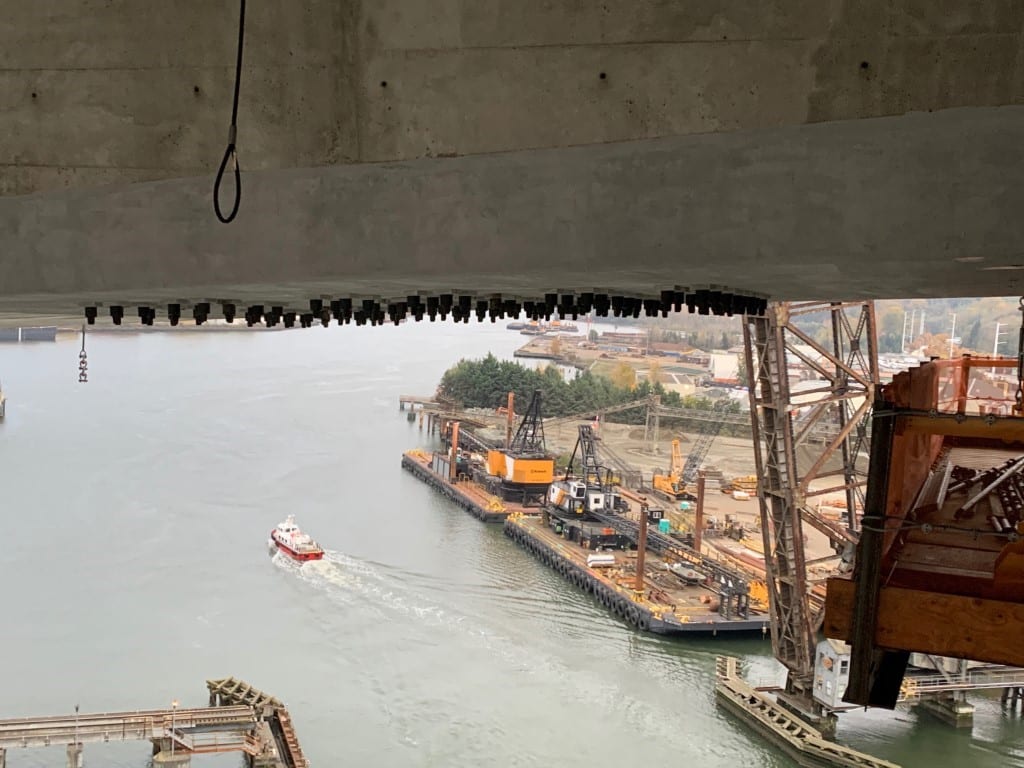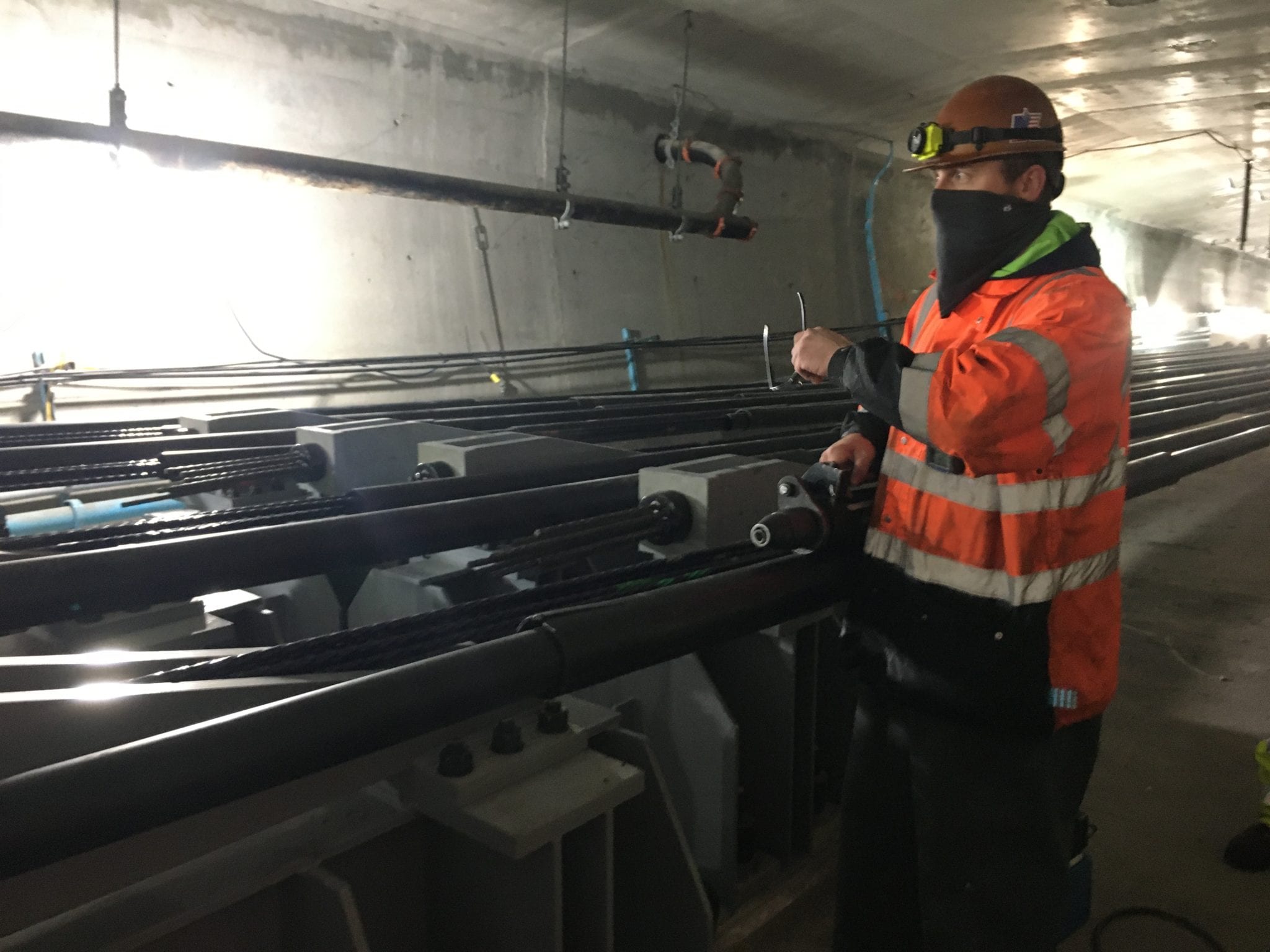Summary
- Work to stabilize the West Seattle High-Rise Bridge reached another important milestone early this week, as crews completed external post-tensioning work.
- Stressing the post-tensioning system reinforces the strength of the bridge’s concrete superstructure.
- We tightened them to 10% in advance of the Pier 18 work but did not tighten them all the way to allow the bridge to move during the bearing release.
- After releasing the bearing last week, we tightened the strands so that the post-tensioning is 100% complete, strengthening the bridge and helping mitigate the risk of further cracking.
- We relied on a local company, Vigor, to quickly provide several different types of fabricated components key to the stabilization work.
Work to stabilize the West Seattle High-Rise Bridge reached another important milestone this week, as crews completed external post-tensioning work that began with the delivery of steel post-tensioning elements over the summer.
This is one of several necessary steps we’ve taken to reinforce the bridge and prepare for future repair or replacement. This milestone comes on the heels of last week’s successful bearing release at Pier 18.
Crews have been working to stabilize the bridge since it was closed in March. Along with carbon fiber wrapping, the external post-tensioning is important because it helps strengthen the bridge and thus mitigate some of the risk of further cracking.
Stressing the post-tensioning system reinforces the strength of the bridge’s concrete superstructure.
You can think of the external post-tensioning system as something like an exoskeleton, designed and installed to strengthen the bridge and support its existing internal post-tensioning system.
Post-tensioning strands: The additional steel strands, or tendons, are part of the new external post-tensioning system. The new strands run along the bottom of the girder interiors between post-tensioning brackets and through deviator blocks to help stabilize the bridge. The external post-tensioning we completed last week is supplemental to the original post-tensioning tendons, which run through ducts in the concrete.
(Right) Temporary work platforms enable crews to do important stabilization work on the West Seattle High-Rise Bridge, and offer a unique view of the Low Bridge.
Before releasing the damaged bearing at Pier 18, we installed the steel post-tensioning strands, bolting them to several brackets inside the girders between Piers 15 and 18.

We tightened them to 10% in advance of the Pier 18 work but did not tighten them all the way to allow the bridge to move during the bearing release. After releasing the bearing last week, we tightened the strands so that the post-tensioning is 100% complete, strengthening the bridge and helping prevent further cracking.
Below is a video that shows how the crews stress the post-tensioning strands.
Our next step is to complete carbon fiber wrapping of the girders now that the bearing at Pier 18 has been released and the post-tensioning work is complete.
Here’s a quick refresher on post-tensioning, why it’s important, and how it works.
All modern concrete bridges have steel reinforcements that increase strength and control cracking. Smaller conventional concrete bridges often use steel reinforcing bars, or rebar. Longer-span bridges, like the West Seattle High-Rise Bridge, require something in addition to rebar to prevent cracking, which is called prestressing.
These “prestressed” bridges use high-strength cables to compress the concrete, so that the bridge can hold a heavier load. It’s called prestressing because it compresses the concrete prior to applying the weight of vehicle traffic to the concrete. The steel cables used to accomplish the prestressing are installed and stressed prior to pouring the concrete (pre-tensioning) or installed and stressed after the concrete has been poured and hardened (post-tensioning).
A local firm, Vigor, has helped respond to the West Seattle High-Rise Bridge closure.

Many Seattleites know Vigor as a local business that builds and repairs large boats and ships from its shipyard at the northern tip of Harbor Island. Vigor is an innovator in heavy complex metals fabrication for a diverse set of industries, including infrastructure. When the need arose to stabilize the West Seattle High-Rise Bridge this past spring, Vigor supported our contractor, Kraemer North America, with critical parts for this effort fabricated from their facility in Vancouver, WA.
“Our facility [on Harbor Island] is right under the bridge, which makes us even more aware of the critical nature of this transportation asset.”
Jill Mackie, Senior Vice President, Public Affairs at Vigor
Vigor quickly provided several different types of fabricated parts key to the stabilization work, starting in the spring:
- Structural steel for the temporary access platforms: The platforms have allowed Kraemer crews to install the components to then safely access the underside of the bridge to install temporary crack arrest measures, which include epoxy injections, CFRP wrap, and external post-tensioning.
- Post-tensioning brackets: These heavy-duty brackets secure the post-tensioning strands. There are 48 steel brackets and each one weighs 3500-4500 pounds. These brackets are installed on the bottom flange on the inside of the bridge. They have temporary anchor bolts to hold them in place on the underside where the bridge needs extra support.
Vigor takes on projects of all different types and scopes. Chris Palmer, Vigor’s Vice President of Production Fabrication, says that this project, “was really positioned for the community. We have a vested interest in preserving safety.” Vigor crews worked 24 hours a day, in “alternate and swing shifts, seven days a week” to complete the post-tensioning bracket fabrication. Palmer explained that Vigor “adjusts […] resources as needed based on demand,” and they appreciated the opportunity to help support the City of Seattle.
We look forward to keeping you updated with the ongoing West Seattle High-Rise Bridge stabilization efforts. In the meantime:
- Sign up to receive regular West Seattle Bridge updates via email.
- Visit our West Seattle High-Rise Bridge website.
- Read our other blogs about the West Seattle Bridge.



